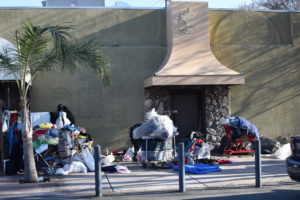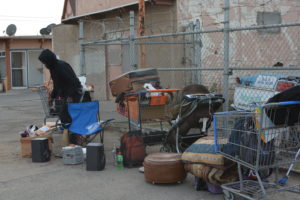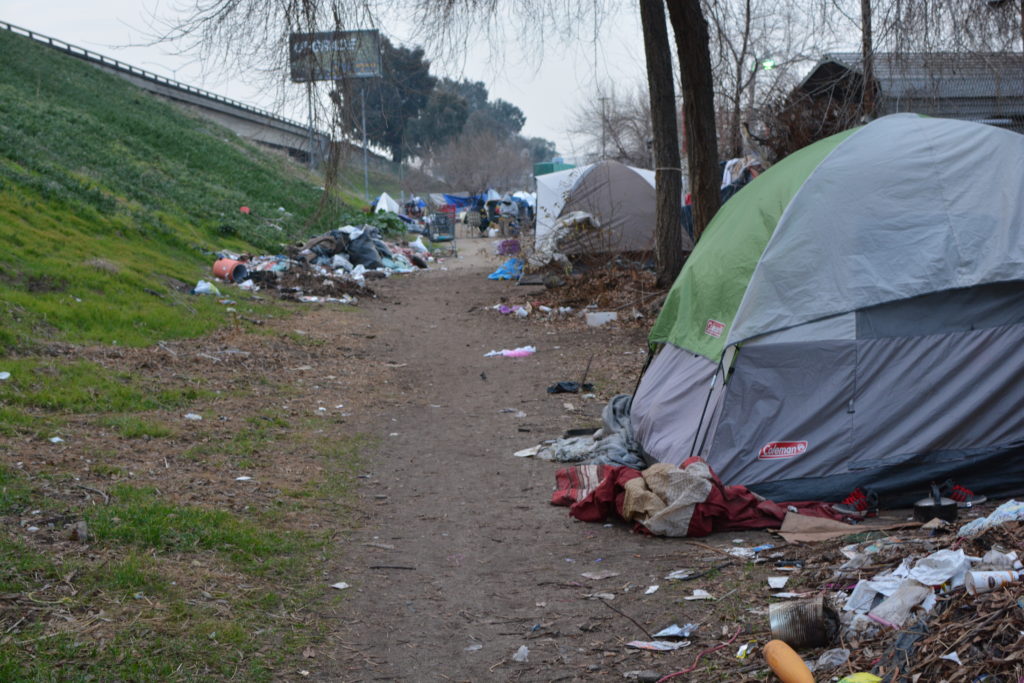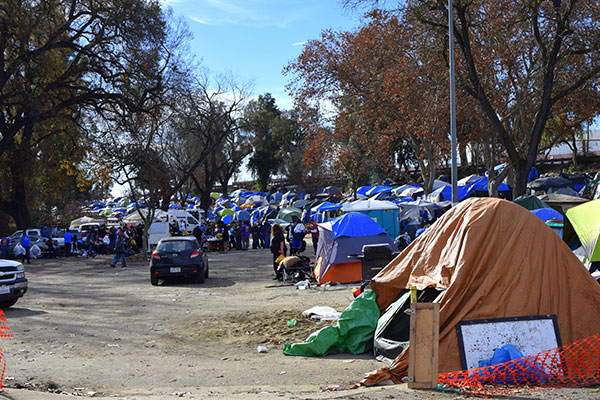
An overflow crowd at Modesto’s first permitted tent encampment in Beard Brook Park has grown to over 400 residents in a few short months and there’s still no shortage of homeless people in their usual haunts, including downtown Modesto. And until there’s better comprehension of the realities behind traditional economic indicators like stock market reports and official unemployment figures, the numbers of homeless and poor people will only continue to grow.
A far better indicator of economic realities in California than the stock market or unemployment figures is the United Way’s annual report, Struggling to Stay Afloat, which features a “Real Cost Measure” that provides a specific assessment of costs of living. A major finding, and one that matches the evidence of our eyes, is that, “one in three households in California, over 3.3 million families— including those with income well above the Federal Poverty Level—struggle every month to meet basic needs.”
Conservatives blame liberals and liberals blame conservatives for California’s high numbers of homeless people, but neither party has yet addressed the real extent of the problem and fundamental underlying causes. Though it may be liberal in terms relative to the rest of the nation, California still lives under the toxic influence of trickledown economics, and nowhere is this more evident than in the San Joaquin Valley, where agriculture is the prime economic engine.
The almond boom, decades old now, never provided an overall boost to the region known as the “Valley of the Poor.” While orchards proliferated and profits escalated throughout the valley, poverty also increased. Among the more telling figures in the United Way report, none reveals more than the one showing Latinos at the highest real poverty rate in the state:
“Nevertheless, households led by people of color disproportionately are likely to have inadequate incomes. While Latino households represent only 29% of the household population in California, 53% of Latino households have incomes below the Real Cost Measure, the highest among all racial groups. Two in five (42%) of African American households have insufficient incomes, followed by Asian Americans (28%), and white households at (21%).”
Especially in the San Joaquin Valley, Latino workers are the glue that holds the economy together. They provide almost all the farm labor and a disproportionate percentage of manual labor overall; they are stalwarts in backrooms of our restaurants, maintain our yards and gardens, and man our rooftops when they need repair. Yet, in a mockery of the virtues that made our nation great, these hard working Americans are punished by an economy rigged in favor those at the top.
Another inescapable factor is the millions of Americans who have been punished by economic realities beyond their control. Donald Trump has generated popular support by blaming the global economy and especially China for America’s manufacturing woes, but in fact it is advances in technology that have presented the death blows for millions of American jobs.
Automation and artificial intelligence, including software, have eliminated jobs and not even the neoliberal notion of “knowledge workers” who gain skills through educational upgrades has replaced those jobs. And the booming tech market, especially in the San Francisco Bay Area, has had the effect of driving up housing prices, not just at its epicenter but in faraway places like Tracy, Manteca, Modesto and Patterson.
The result has been added stress on working people, especially the working poor. In fact, the Real Cost Measure reveals that those who struggle most in California spend over, “half of their income on housing, more than twice as high a share as households living above the Real Cost Measure.”
One of the hidden effects of trickledown economics is the impact on social services. It is no accident that even in so-called “liberal” California the losses in tax revenue brought about by tax cuts for corporations and the wealthy have resulted in regressive road, sales, and library taxes.
In 2020, voters will be asked to take a closer look at Proposition 13, historically an untouchable policy because of its protection of residential property owners. But Proposition 13 has also proved a windfall for business interests, and even the reevaluation exempts agriculture from possible tax increases.
But agriculture and San Joaquin Valley farmers already profit tremendously from favorable tax policies, not to mention publically funded projects—everything from roads and bridges, to the dams, pumps, and canals that move their water up down the valley. Many pay less than the cost of delivery for their water, and they are exempt from sales taxes on farm equipment.
Given these advantages, plus routine government subsidies for dairies and rice farmers, one would think the San Joaquin Valley should have profited immensely from trickledown economic theories. In fact, it remains battered by poverty. Almost forty percent of residents of Stanislaus County live below the Real Cost poverty measure and in Merced County the figure is closer to fifty percent.

Of course, it’s not just agriculture that has failed to deliver under trickledown theories. California’s economic boom in the tech and entertainment industries has also failed to deliver an equitable distribution of wealth. The same is true nationwide; even as the stock market booms and unemployment numbers drop, American workers continue to struggle to make ends meet.
Things will only get worse until the American people reflect on over thirty years of failed trickledown economic theory. Until then, they’re far better off using the evidence provided by their eyes and ears than listening to propaganda spread by talk show hosts and a president whose first order of business was a tax cut for the wealthy. And if they need more evidence than that provided by their eyes and ears, they can always consult United Way’s full report on the Real Cost Measure of living in California.



People need more affordable housing smaller and more efficient homes must be built for the hard working poor.
Affordable public housing that is built costs multiples of what it should. Builders rake in huge profits at taxpayer expense, making the cost per unit greater than larger homes built by the price sector. For example, the apartment sized homes built at Carver Road and North Ninth cost $240K each.
The private sector does not want to build homes that are affordable for the poor because greater profit exists in building McMansions.
Ultimately, local governments will need to mandate construction of affordable homes in conjunction with the approval of McMansions or by zoning ordinances. Both ideas are opposed by the building industry, which controls or heavily influences local city councils.
Los Angeles has implemented a substantial affordable housing efforts. We will know whether it is working in a few years. If it works, we will have a model worth emulating.
The winds of divisiveness are thick with clouds of fear, hatred, threats and lies – and that smoke belongs to both Democrats and Republicans. The reality behind the smokescreen is its raison d’être: the fact that we all have vastly, YUGELY more common ground and common cause than differences. If I and my hispanic, Asian or black neighbors are all poor, unemployed or underemployed despite our best efforts, we have common ground. Our common cause should be seeking the tide that lifts all boats, not the one that floats mine and leaves yours on the shoals. For the last half-century and more, our country has been mostly controlled by the corrupt. Today, it’s virtually entirely under the control of grifters and sociopaths. Their greatest weapon is the ability to turn us against each other. They know our common ground far, far better that we do, and they’ll do anything to keep us from discovering it.
Meanwhile, the nation is literally falling apart by so many measures. The epidemic of homelessness – economic refugees made up of the most vulnerable – will simply grow until we as a nation finally grow up. We’re running out of time.
It’s the economy? Not necessarily. I think alot of it is the American culture which has been dumbed-down into becoming brainless consumers…in other words, stupid people. People are constantlybombarded with incessant commercials and advertising on iphones, television, radio, mailers, newspapers, etc and like lemmings rushing to the sea, run out and buy stuff they don’t need. So, in a way, they are simply doing what they’ve been programmed to do. Shopping has become America’s favorite pastime. They have become pawns in Wall Street’s need to keep the wheels of capitalism turning and the demand to prevent market downturns. They fail in money management’s 1st commandment: “do not live beyond your means.” They live paycheck to paycheck driving cars they can’t afford and in houses they will never own…they are 100 lbs overweight and push over loaded grocery carts, and pay for it with food stamps.
Thank you for this opportunity to reply. I will not address the liberal creation of poor government economics. Instead, I am surprised how a picture does not tell the whole story, current photos of the homeless. Modesto became the damping ground by the bay cities! Many of these homeless were bused by the Bay Area counties! Now the image being posted blame Modesto area for the tragedy!